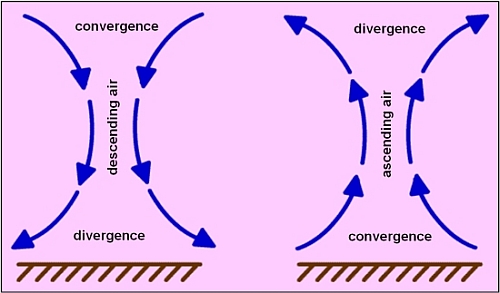Convergence and Divergence
Convergence and Divergence
LEUNG Wai-hung
June 2010
Generally speaking, ascending air often leads to formation of cloud and rain, while subsidence brings fine weather. Weather is directly affected by the vertical motion of air which, in turn, is influenced by horizontal convergence and divergence.
Air masses at different places usually move at different directions and speeds. They may move in varying directions and speeds. Sometimes, they propagate in the same direction but at different speeds, or at the same speed but in different directions. Such irregularities cause air to pile up somewhere and to spread in other region. Figure 1(a) shows that air masses are moving away from a line or a point; and Figure 1(b) shows that spreading of air is caused by air masses moving faster than those behind them. This phenomenon is called horizontal divergence. On the other hand, Figure 2(a) shows that air masses are moving towards a line or a point; and Figure 2(b) shows that piling up of air is caused by air masses moving slower than those behind them. This phenomenon is called horizontal convergence.

Figure 1(a) Air masses are moving away from a line or a point

Figure 1(b) This figure shows that spreading of air is caused by air masses moving faster than those behind them. This phenomenon is called horizontal divergence.

Figure 2(a) Air masses are moving towards a line or a point

Figure 2(b) This figure shows that piling up of air is caused by air masses moving slower than those behind them. This phenomenon is called horizontal convergence.
In the atmosphere, the distribution of horizontal convergence and divergence of air is rather complicated. Sometimes, convergence occurs at the low level and divergence appears aloft; while the opposite may occur at other times. From Figure 3, we can see that convergence at the upper part of the troposphere together with divergence at the lower level will lead to downward motion of air and bring fine weather. If the opposite occurs, upward motion of air will be developed, leading to the formation of cloud and even rain. The concept of convergence and divergence is very important in weather forecasting and therefore forecasters often look into regions of convergence and divergence on the forecast charts.

Figure 3 Horizontal convergence, divergence and vertical motion of air